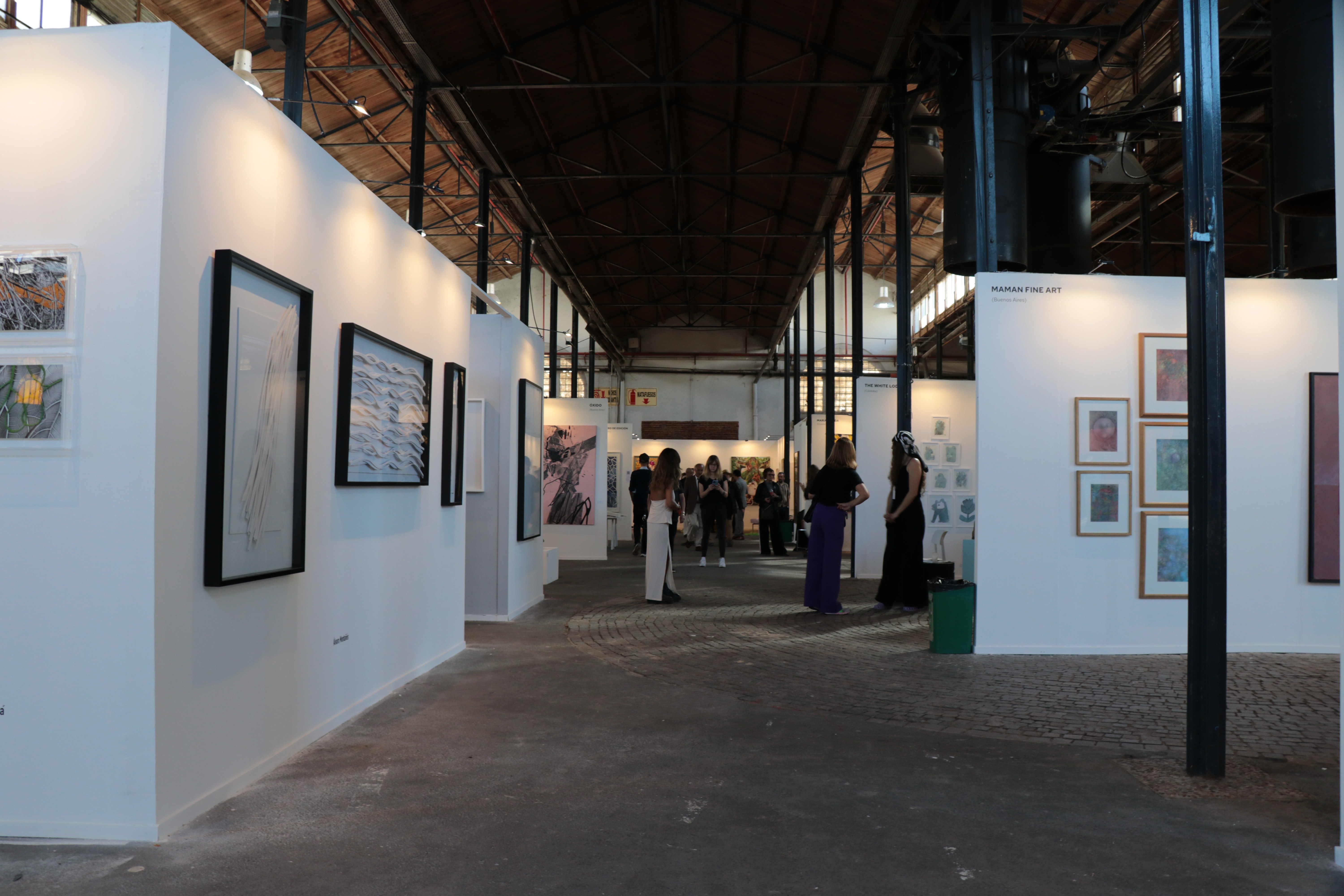By Julieta Ogando
Nicola Constantino
PaRDes Workshop
Mar 11, 2025
FEROCIOUS BEAUTY AND MUTATING NATURE
From the first time I saw a work by Nicola Costantino, I was caught in a back-and-forth between fascination and disturbance. It was in the Palacio Libertad—formerly CCK—where her imagery imprinted itself in my memory forever. At that moment, something in her universe reminded me of The Cell, that movie where horror and the dreamlike intertwine in baroque, excessive settings, loaded with primitive impulses. But Nicola's work is something much more palpable. Her art creates a tension between aesthetic pleasure and disturbance, in that unavoidable attraction to what discomforts.
In Costantino's work, that intensity translates into an iconography that is not afraid to plunge into hells—the pictorial, the mythological, the internal—and that touches a chord that, in my case, had always been latent: the obsession with death, transformation, and the reconfiguration of bodies.
At that moment, what captivated me about her work was that deep connection with the iconography of the imaginations that had obsessed me since I was very young: the biblical representations of hell and the Apocalypse. Her pieces seemed to feed an interest that until that moment had only lived internally. And now, getting to know her studio was like opening a door to her world, a space where nature—alive and dead—intertwines with impeccable technique and the thought behind each image.
The body as territory, nature as metaphor
Costantino's work unfolds in multiple mediums: ceramics, textiles, installations, video, even beautiful silk worms. Her art oscillates between the organic and the artificial, the living and the dead, exploring cycles of transformation and decay. It is no coincidence that flesh, animals, skins, and fragmented bodies are a constant in her production. There is something in her way of representing matter that evokes Flemish painting, the still lifes of the Baroque, and the vanitas of the 17th century, but with a necessary layer of contemporary meaning.
This drive for the ephemeral and transformation is also felt in her reinterpretations of classical works. Taking genres like still life and re-signifying them is more than an aesthetic gesture: it is a reclamation. Her work not only rescues these traditions but also rewrites them with her own visual poetics. In her installations, time condenses, and the image becomes a threshold between the symbolic and the real.
The body, artifice, and pictorial inheritance
If there is something that defines Nicola Costantino's work, it is her ability to re-signify images that are part of the collective imagination. Her reinterpretation of still life and the aesthetics of Flemish bodegones reminds us that putrefaction and beauty are inseparable. Fleshly flowers that seem to have come from a hellish greenhouse, dishware that mutates into sculptural objects, fragmented torsos that evoke the most extreme mannerism: each of her pieces holds a tension between the baroque and the surgical, between seduction and excess.
Costantino understands that art must provide aesthetic pleasure, but it is not about superficial or merely ornamental pleasure. It is a pleasure that awakens the skin, that captures the gaze, and that, at times, brushes against the morbid. There is something in her compositions that generates immediate visual pleasure, as if each element were arranged with mathematical precision to provoke a visceral reaction. Her work does not remain decorative nor seeks to be pleasing: it is hypnotic because it drags the viewer to a threshold where form and meaning are in dispute. The hyper-realistic textures of her pieces seem to challenge the boundaries between the living and the inert, while her assemblages of fragmented bodies and hybrid natures raise a reflection on materiality and identity.
Between Eden and metamorphosis: bodies, nature, and artifice
The images of hell have been a recurring obsession in the history of art (and in mine), from medieval miniatures to the Dantesque visions of Hieronymus Bosch. Costantino takes that imagery and reconfigures it with a language that is profoundly contemporary. In her studio, horror and the organic coexist in perfect harmony: inverted bodies, animals in impossible positions, flowers that seem to devour space. Her work is not a simple exercise in provocation, but a way of confronting the cycle of life and death with a poetics that is as precise as it is wild.
If The Garden of Earthly Delights by Hieronymus Bosch presents the viewer with a world where Eden, earthly pleasure, and Hell coexist without a clear hierarchy, in Nicola Costantino's work that duality becomes even more ambiguous. There is no fixed destiny or linear narrative: everything seems to be in perpetual transformation. Nature is not just the background, but a mutable body that opens, folds, and reproduces with the same organic cadence of skin, flesh, and desire.
On the other hand, her photographic characters, with calculated androgyny, escape a fixed identity: hybrid bodies that defy classification, in scenes where the photographic becomes performative. For Nicola, photography is not just recording, but action, gesture, and intervention upon the image.
Just like in her ceramics and mosaics, where the series does not detract from the work but amplifies it, in her photographs the concept of reproduction opens new layers of meaning. There is not a single definitive image, but a process in which the material—be it skin, silk, or clay—is in constant negotiation between what was and what is to come.
Material as legacy: perfection, memory, and permanence
Nicola Costantino finds in materials a dimension that goes beyond their utility or appearance: she understands them as entities with their own history and symbolic weight. For her, silk is an example of absolute perfection, a material that needs no intervention to reach its maximum expression. It is not about transforming it, but recognizing its excellence as it is.
In contrast, ceramics offer her another relationship with matter, a connection to the ancestral. Working with clay implies touching a substance that has been with humanity since forever, which has transformed from being tool and utensil to becoming art. There is something almost ritualistic in that contact, in the way ceramics are molded, fired, and become objects that can last for centuries.
Her exploration with clay is not only technical but also philosophical: a reflection on permanence, on how noble materials have accompanied civilizations and continue to hold relevance in a world that produces faster and forgets with the same speed.
The value of repetition and the beauty of accident
Among the multiple techniques Nicola Costantino masters with almost surgical precision, there is one in particular that dismantles any rigid notion about uniqueness in art. The eastern ceramic method nerikomi (練り込み) allows the same image to be replicated in multiple pieces through the compression of colored clay forms. Each cut reveals an identical pattern, like a genetic footprint multiplied in series. But far from reducing the work to a simple mechanical exercise, Costantino challenges the idea that repetition diminishes singularity: in her universe, the series is not synonymous with the industrial, but with an impeccable technique that turns each fragment into part of a whole.
Alongside this absolute mastery of form, the artist has also chosen to open a dialogue with the fragility of the material. In her work with mosaics, she has incorporated those pieces that break in the process, re-signifying the error and giving space to the unexpected. It is not a corrected accident, but an accepted one: a way of integrating the fate of each fragment into the final structure. In this tension between control and chaos, precision and breakage, Costantino reminds us again that matter is not static, and that in every crack there is also a possibility of beauty.
To vary, because contemporary art often dilutes in unsubstantial discourses, Nicola Costantino's work stands as a visual manifesto that confronts us with the inevitable: transformation, decay, and the eternal search for beauty, even in the darkest aspects. Her technical talent is undeniable, but what impacts the most is her way of constructing authentic ideas, of inhabiting her own visual universe without concessions.
Entering her studio was like entering a materialized delirium, a space where every object hides a story of mutation and every image is a door to a world with no return. A universe where life and death shake hands in an eternal dance.
And yes, I hope to return. Because there are worlds that are not traversed just once.









